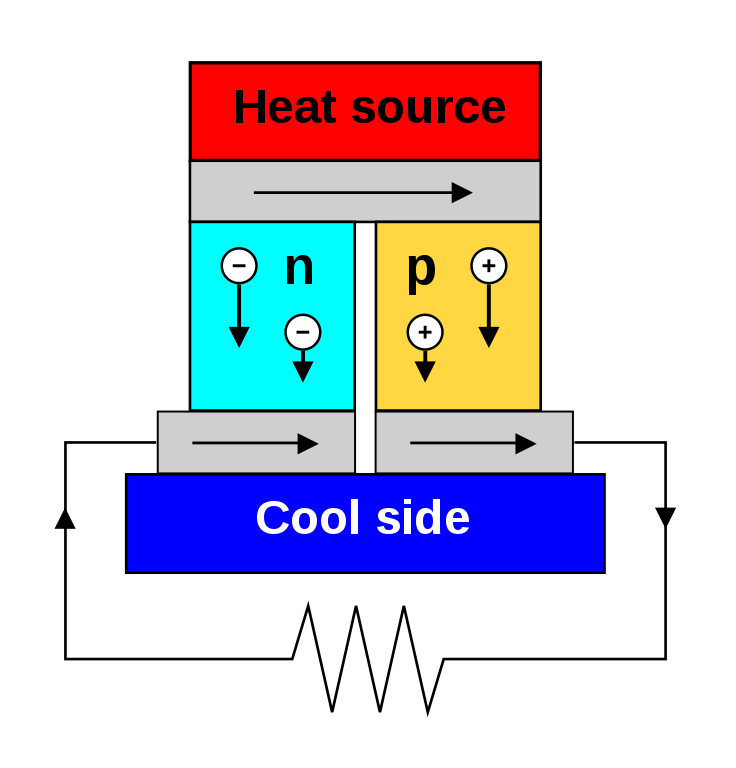Researchers from India's Vellore Institute of Technology have developed an experimental system, coupling PV with a thermoelectric generator (TEG) and a graphite sheet as a heat dissipation element.
TEGs can convert heat into electricity through the “Seebeck effect,” which occurs when a temperature difference between two different semiconductors produces a voltage difference between two substances. The devices are commonly used for industrial applications to convert excess heat into electricity. However, their high costs and limited performance have thus far limited their adoption on a broader scale.
“The fundamental purpose of this research is to integrate PV-TEG with graphite as a heat dissipator,” the academics explained. “TEG converts excess heat into electricity, while graphite increases heat dissipation and temperature difference. Therefore, a low-power PV panel backside glued with a TEG-graphite sheet has been tested and controlled to study this approach.”
The TEG part of the experimental setup consists of n-type and p-type pairs, generating electric voltage with temperature differences. The setup included a 150 W monocrystalline silicon PV panel measuring 1,135 mm × 665 mm, with an efficiency of 18 %. Using a thermally conductive adhesive, the researchers then glued 186 commercially available TEG cells to the rear of the PV module. Each TEG consists of two ceramic layers of 0.5 mm and 2 mm, respectively.
The academics tested the setup against a reference system consisting of a graphite sheet as a heat dissipation element. The graphite sheet, with a thickness of 0.05 mm, was pasted using the same adhesive to the heat dissipation side of the TEG.
“The graphite sheet's remarkable resistance to heat and its dependability contribute to the possible longer service life and higher performance,” explained the research group. “It is cost-effective because it may help streamline some existing procedures. Although graphite is a much lighter material, its conductivity is comparable to copper.”
The academics took measurements of the systems on a rooftop at an average interval of 48 minutes under solar irradiance of 425.1 W/m2. “The TEG power output relies on the temperature gradient between the PV panel's backside and the TEG cold side,” they explained. “The graphite sheet aims to increase the heat rejection rate from the cold side of TEG. Hence, the cumulative output for this case is that TEG-graphite rises.”
Through the testing, they found that the system's maximum output without graphite sheet output was 10.871 V, with a temperature gradient of 4.567 C. That is to be compared with a maximum output of 13.515 V, with a temperature gradient of 6.682 C, when using a graphite sheet. They also found the temperature on the graphite side was 31.255 C, while on the opposite side of the TEG, it was 37.937 C.
“It is a general estimation that the peak radiance in summer exceeds 900 W/m2, consequently causing an increase in the temperature gradient,” they added. “So, it is more likely that the same PV-TEG system can give a relatively higher output voltage. In this case, the theoretical estimation of TEG module voltage increases is 24 V, which equals PV-panel voltage.”
Their results were presented in “Experimental study of photovoltaic-thermoelectric generator with graphite sheet,” published in Case Studies in Thermal Engineering.
This content is protected by copyright and may not be reused. If you want to cooperate with us and would like to reuse some of our content, please contact: editors@pv-magazine.com.



By submitting this form you agree to pv magazine using your data for the purposes of publishing your comment.
Your personal data will only be disclosed or otherwise transmitted to third parties for the purposes of spam filtering or if this is necessary for technical maintenance of the website. Any other transfer to third parties will not take place unless this is justified on the basis of applicable data protection regulations or if pv magazine is legally obliged to do so.
You may revoke this consent at any time with effect for the future, in which case your personal data will be deleted immediately. Otherwise, your data will be deleted if pv magazine has processed your request or the purpose of data storage is fulfilled.
Further information on data privacy can be found in our Data Protection Policy.